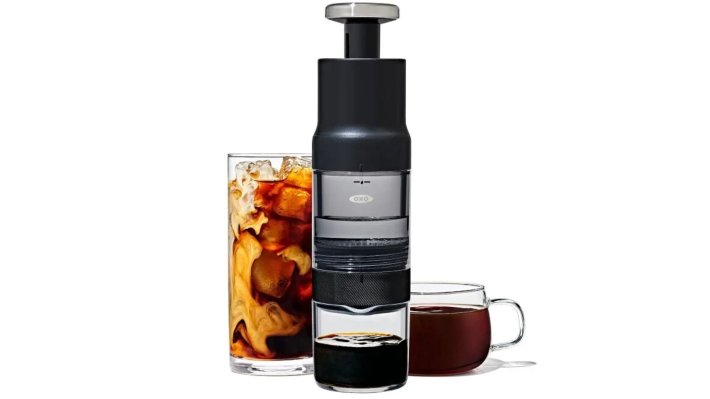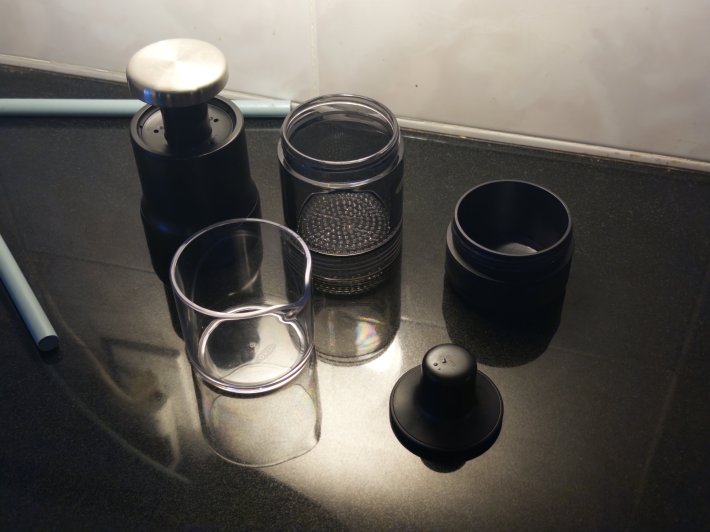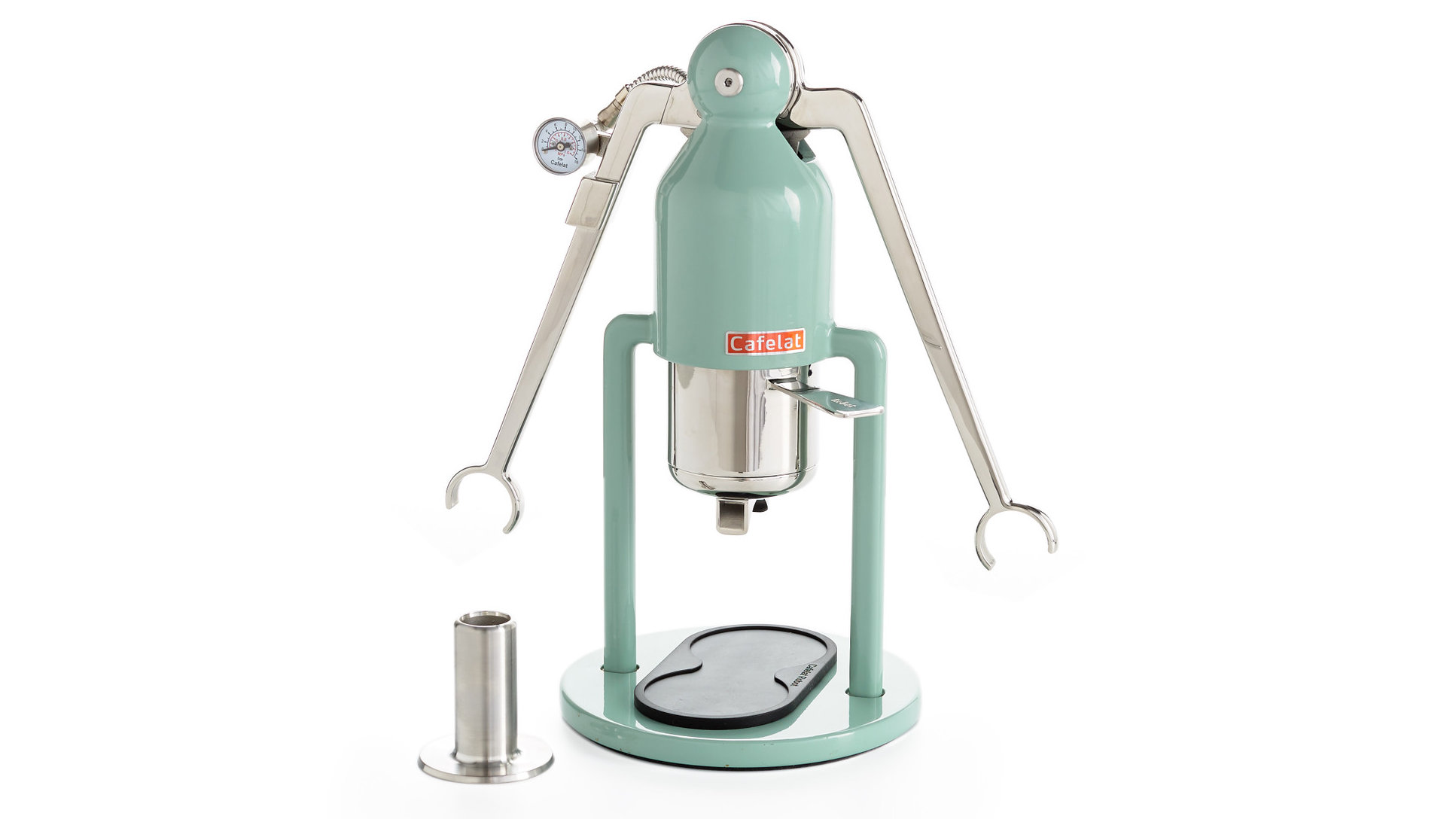“I do not need another coffee device” is what I told myself recently. I have already spent countless hours powerfully disassembling, powder coating, and modifying an off-the-shelf espresso machine, and it serves me perfectly. I have an Aeropress, a pour-over, and a beautiful, gothic Alessi Pulcina moka pot. And yet when I saw what people were doing with the OXO Brew Rapid Brewer, I sighed, because someone had finally gone after Aeropress, and succeeded in making something new.

A New Portable Coffee Contender
The OXO Brew Rapid Brewer (I have seen people affectionately dub it “ORB” for short) is a compact coffee maker that claims to make hot or cold concentrated coffee in less than five minutes. To make a cup of coffee you disassemble the machine, place the included carafe under it, grind some fresh beans, pour the grounds into the lower basket, tamp it down with the self-stored tamper, then pour hot or cold water in the top chamber of the container. When you’ve reached the correct immersion time, you force water through the puck by pressing the built-in pump, which forces air out, sort of like a bike pump. Individual factors depend on how you’d like to brew. It’s a beautifully designed machine, and the constituent parts of the pump, carafe, and the tamper are all self-contained in a way that collapses down for easy storage.
The immediate thought you may have is “that seems like an Aeropress,” a beloved staple of the coffee world and campers in particular, and I would say “sort of.” The Aeropress typically uses paper filters, which the Rapid Brewer does not need if you use it as OXO suggests. The Rapid Brewer creates a chamber with a dense puck more akin to the kind you make when you make a shot of espresso, while the Aeropress has an immersion chamber, and when it’s done the coffee gets forced through a paper filter like an oversized syringe. Though they serve a similar market, and both would be handy for making coffee while camping, the Rapid Brewer works in a fundamentally different way.

The Rapid Brewer would be noteworthy enough on its own, but what truly makes it novel is how the coffee community has found ways to use it. It came to my attention originally thanks to coffee YouTuber Lance Henrick, who had originally seen that it had become the pet project of a channel on the Espresso Aficionados Discord (which I was conveniently already in) called the Soup Kitchen, dedicated to making what are dubbed “Soup” shots.
From Turbo To Soup

Modern espresso styles have changed over the last few years, with much of this changing due to “turbo shots.” The turbo shot originated from a research paper in 2020 and is a style of smooth espresso shot that uses lower pressure, coarser grinds, and a much shorter extraction time. Traditional espresso machines typically force water through a puck of finely ground coffee at about nine bars of pressure, while the turbo shot initially only used six. The resulting shot is sweet, floral, and easy to drink. Getting a turbo shot out of a traditional espresso machine is not possible unless you are either using a machine that has flow profiles (like the Decent or the hacked Gaggiuino I built) or you are using a manual espresso machine like the Flair58 or the Cafelat Robot with a gauge to measure the pressure.
“Soup” is a further evolution of styles like turbo shots and other low pressure shots. Though terms like “soup,” “yeet,” and “piss” had been kicking around in the Espresso Aficionados Discord to describe these styles, “soup” was eventually chosen because it is more family friendly. It was originally popularized by user DC, although he stresses that he did not “invent” it per se. After much experimentation, the “Soup Kitchen” thread was established, with DC showing the style off on a Cafelat Robot – my favorite manual espresso machine because it looks like a little pastel robot guy that wants uppies. Soup calls for even lower pressure than turbos (never exceeding one bar) and a grind with twice the burr gap of a turbo shot. Lighter roasts are often employed. Circular paper filters are added to the bottom before the grounds, with an additional one added to the top for cleanliness and puck consistency (DC prefers Chemex filters cut to size for the bottom).The puck is preinfused super gently, often with the assistance of a tiny $7 dollar folding mirror. DC described his ideal soup to me as “Very forgiving to dial in, like a pourover while highlighting complex acidity in coffees, aromatic.”
The resulting “shot” produces foam but no “crema” like a traditional espresso or turbo. It’s clear and drinkable like a pourover, an extraction level similar to espresso but with none of the oily body. Eventually, the members of the discord realized that OXO excelled at making soup shots, and a cult began to form around the device. According to DC, the Rapid Brewer “makes it really easy to do a soup shot because it prevents you from building too much pressure by accident while giving you tactical feedback about puck resistance.”
Soup’s On
Since I was already set up for espresso, I was already set up for soup. I needed a lighter roast than what I was used to, so I went with Pink Bourbon from Variety Coffee. Soup calls for near boiling water, and conveniently I have a Zojirushi water boiler that I use for tea. You don’t strictly need a Japanese water boiler, but mine is one of the single most useful appliances in my house. It’s a big self-heating vacuum flask with variable temperatures and pour speeds that makes it so you constantly have hot water at precisely the right temperature at all times. Soup’s grind size takes a while to dial in, but a good rule of thumb is that water should be very nearly dripping through when you pour it in without applying additional pressure; for me, that’s roughly in the area between a fine moka grind and coarser espresso grind.
Recipes vary depending on a number of factors, but generally for the stock orb I’ve seen people suggest 18-20 grams of coffee and roughly 82 ml of hot water. Soup requires additional filtration in the form of paper filters above and below the puck. Aeropress filters are slightly too large for this purpose but will work in a pinch, although I’ve heard custom-cutting Chemex filters to size is a meaningful improvement. You place a filter in the basket, place your freshly ground and dosed coffee over it (WDTing if you like), lock it into the brewer, place it over the carafe, pour the correct amount of hot water, and place the pump on it. Preinfusion is the most important part, and the first pump is done as slowly as possible to saturate the coffee puck. Brewing time is short, about 20 seconds in total. Once the puck is saturated and you can pump without resistance, go to town on it. Congratulations, you’ve made soup.
As an espresso drinker, soup is a bizarre drink. It’s about the volume of a lungo shot, with the clarity of a pourover. Though it does not have the oily, viscous consistency of espresso that I love, it has an extraction that’s closer to it than other forms of coffee. It's like mutant pourover. If you make it correctly, soup is strong and beautiful, exceedingly floral and seductively clear. I have heard people describe it as “juicy,” which is a bizarre descriptor for any coffee drink, but it’s an apt one. Soup is exceedingly drinkable and downright beguiling. I have seen multiple people claim that their espresso machines have laid dormant since they started pulling soup shots. I have not, but I see with the utmost clarity why.
The Rapid Brewer does not replace espresso machines, but it’s cheap (in the US), well built, and lets you try a bizarre style of drink that you could mainline for the rest of your life. You do not need the level of investment as an espresso machine to get it right: A simple digital scale, hand grinder, a kettle and some filters are enough to get you there. Though many devices can make soup, none are as cheap and convenient at the task as the Rapid Brewer. You know a product has “the juice” when you see people 3D printing custom accessories for it, and rabid coffee fans have already found ways to modify the Rapid Brewer to take different espresso basket sizes. I have a good feeling that the Rapid Brewer is more than a simple fad. The ORB has escaped containment, it’s making soup, and the coffee world might never be the same.


